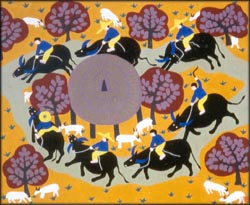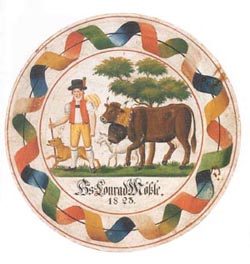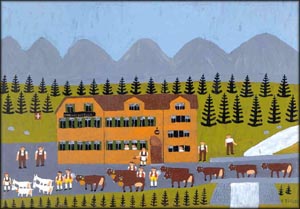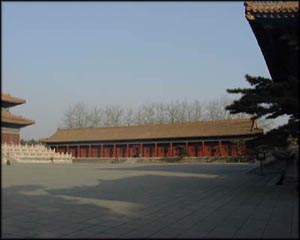On October 9th this exhibition will open in the Eastern Hall of the Working
People's Palace in Beijing. Around eighty paintings from various museums and
collections in Switzerland and 40 Chinese paintings will be on display until
October 21st 2001.
Farmers' art from Eastern Switzerland and various Chinese provinces
One of the characteristics of Swiss art is the unusual presence of lay art. Eastern Switzerland, the region around the dominating Säntis mountain, is particularly rich in such painters. These artists have long been held in high esteem on account of their originality and expressiveness. They are called bauernmaler, i.e. farming painters, although many were not farmers but farmhands or simple craftsmen. What all these so-called "farming painters" have in common is that they all come from the lower social strata and - how could it be different in such an original region - had a close relationship with farming life, agriculture and the alpine pastures. This, then, is what they expressed in their art.
The painters from Beijing, Tianjing, Shanghai, Henan Province, Jilin Province, Shanxi Province, Xinjiang, etc., depicted scenes from their daily rural life. Apart from obvious differences in style, there are similarities. Farmers throughout all five continents maintain close links with nature; they experience the changing seasons much more intensively than a craftsman who works under a roof, and certainly more intensively than an official. Regardless of the differences between Chinese and Swiss agriculture, the paintings still demonstrate a similar affection for the plants and animals these farmers cultivate and rear. In both countries, the pictorial world corresponds to how the farmers themselves experience their surroundings.

Another similarity is revealed by the great interest in pictorial rhythm, in the deliberate repetition of certain pictographic elements. This multiplication is an effective trick but can also serve to represent the prosperity that has been achieved, i.e. the pride in achievements earned through hard work. China's farmers' art teems with carp and ducks; Eastern Swiss painters show long rows of cattle trotting towards alpine pastures in grave dignitiy.
We hope that this exhibition will both contribute towards these works of art, which have been created by simple people, and will be able to help different cultures to know each other better and hold each other in higher esteem.
Cattle drive to alpine pastures
In the summer, Eastern Swiss farmers drive their cattle to one of the many alpine pastures. At high altitudes, summer usually comes late, and winter early. In many years, the herds' time on their alpine pastures is limited to a mere two to three months. In many parts of Switzerland, the drive to and from alpine pastures is done with cattle trucks. In Eastern Switzerland, however, the custom of a festive procession has survived, for which the animals are thoroughly scrubbed and decked out. Farmers and herdsmen wear their colourful costumes.
On the alpine pastures
Thanks to the system of alpine pastures, high-altitude areas, where hardly any crops could be cultivated, can be put to economic use. The animals' owners profit from this in two ways: firstly, the grassland of their lower-altitude farms can be used to harvest dry feed for the winter season, and secondly, when the animals return to their barns in the autumn, they are well nourished and tough. - On the alpine pastures, cows' and goats' milk are processed into butter and tasty cheese on site. The animals spend the night outdoors.
 Bödeli: the painted bottom of the carved wooden milking pail Bödeli: the painted bottom of the carved wooden milking pail
A bödeli is a round painting that is fitted to the bottom of the wooden milking pails with brackets. During the drive to and from the alpine pastures, the herdsmen proudly carry these pails on their left shoulders, thus displaying the works of art. Since the milking pails are actual utensils, the bödeli is removed on arrival to protect it from dirt and wear, and hung up as an ornament in the alpine cabin or in the farm. These paintings depict alpine cattle drive scenes. The initials or names which appear on them do not refer to the artist but to the bödeli's owner or his forebears.
Those who are called late in life
None of the three artists strives for perfected expression. They are aware that they cannot compete with professionally trained colleagues. However, this deficit does not in any way interfere with their self-confidence, and certainly not with their childlike pleasure in creation. - Niklaus Wenk's paintings represent farming work as it used to be before mechanisation.
The outsiders
None of the three artists strives for perfected expression. They are aware that they cannot compete with professionally trained colleagues. However, this deficit does not in any way interfere with their self-confidence, and certainly not with their childlike pleasure in creation. - Niklaus Wenk's paintings represent farming work as itused to be before mechanisation.
Sennenstreifen: boards showing cattle drives to alpine pastures
Since the early 19th century, boards depicting cattle drives to alpine pastures - the so-called sennenstreifen - have been placed above barn doors. They are oblong representations of the cattle owned by a particular farmer. Many of these paintings show an actual inventory, true to life, whilst other were quickly made with stencils and mainly serve to provide information about the number of animals living in the barn. Whereas the bourgeois society of the time lived according to the motto "Modesty is a virtue" and understated their wealth, Eastern Swiss farmers never knew such reticence. In contrast to the big merchants and manufacturers, they used their costumes and jewellery, their utensils and sennenstreifen to make their modest prosperity visible to the outside world.
Appenzeller St Sylvester mummers
The St Sylvester mummers date back to pre-Christian times. They are bringers of light, but also figures of terror. A distinction is made between "beautiful mummers" and "ugly mummers". Both costume types are created by farmers and craftsmen in many days' work. This exhibition shows "ugly mummers", who are normally dressed in garments made of fir twigs, fir cones, tree lichen, moss, woodchips or woodwool.
Hans Ulrich Gantenbein and Hans Büchler - photos
The professional Appenzeller photographer Hans Ulrich Gantenbein - who has attracted particular attention with his sensational panorama shots - and the St.Gallen historian and folklorist Hans Büchler contribute photographs to the exhibition which make the Eastern Swiss artists' environment visible with the accuracy of the camera. They prove that the world that was represented by the painters still exists in reality. There is no danger of the landscape being artificially changed by human intervention, and the customs of the alpine cattle drives and the St Sylvester tradition will undoubtedly be maintained.

During the exhibition period there will be frequently performances of Swiss
traditional folk music (usually in the afternoon around 2 to 3 pm). Visitors
can taste local specialities from Switzerland (cheese, smoked meat, ...) and
even win Swiss souvenirs when giving the right answers in a small country quiz about Switzerland.
For any further questions regarding this exhibition: vertretung@bei.rep.admin.ch
|


 Bödeli: the painted bottom of the carved wooden milking pail
Bödeli: the painted bottom of the carved wooden milking pail